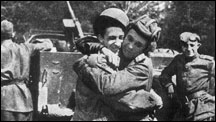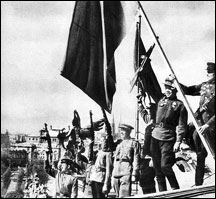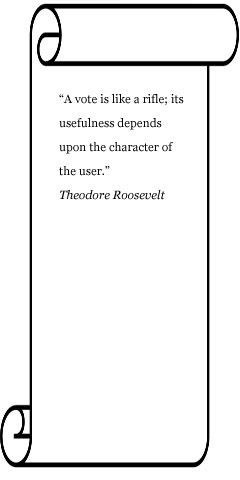| Red
Vengeance: Nuts and Bolts
William Sariego
August 2013
It has been a few years since I previewed
Red Vengeance. Now that fans have had
a chance to play, enjoy, or rant against
it, I have decided to come back with an attempt
at some proper designer's notes. While not
definitive, I hope this brief insight into
my mindset will help player's get a feel for
what I was trying to accomplish. I would also
like to take this time to make my appreciation
known to all those whom put forth effort in
helping my ideas reach print. Following up Defiant
Russia with a sequel was no mean task.
| 
Comrade Sariego redecorates the Reichstag.
|
I've stated this before but it deserves to
be said again: Big, hyper-realistic games
are cool and I've both collected and played
many. Streets of Stalingrad, Red Parachutes,
and The Longest Day have all seen
playing time in my life. Yet when Pushkin
comes to shove, it always seems that it is
games like Battle for Germany, Panzer Grenadier:
Airborne, and The Russian Campaign
that I keep playing over and over.
Red Vengeance was designed with my
love for playability in mind. Simple and playable
does not have to equate with simplistic, however.
Despite the simplicity of Defiant Russia
and Red Vengeance, both games have
a lot of chrome around the solid core. In
Red Vengeance I wanted to once more
highlight things that often get overlooked
at a corps/army level game set in the ETO.
Hence you have the rules for naval operations
and leadership. And trust me, the 140-counter
mix limit caused me to eliminate a few cool
“gonzo” units! Stay tuned for
a May Day variant for Red Vengeance
that will include my madness with a free web
download.
Changes abound between Defiant Russia
and Red Vengeance. This is both
an attempt to improve the system and respond
to the changing wartime situation. Shock armies
operate in an improved manner and German infantry
has deteriorated. These are reflective of
the changed historical situation. Winter hurts
the Soviets also. The Red Army has hardly
deteriorated in this aspect, yet they were
at their ropes in logistically as 1945 dawned,
and the onset of snow and its affects were
but another way to slow them down and reflect
this without elaborate supply rules. Gone
are the railways (in part due to the feedback
I've received) and in its place comes Strategic
Movement and simplified supply rules. These
are just a few of the more obvious modifications.
The Red Fleet proudly sails once more, and
this time the Kriegsmarine makes its presence
felt in a big way.
When Defiant Russia begins, as the
whole world collectively holds its breath
on June 22nd, 1941, we have a static situation.
In Defiant Russia the Soviets set up
first and the Axis got the first turn. I should
have just started the game with the Axis Combat
Phase! June 22nd, 1944 represents a different
and more fluid situation on the eve of Operation
Bagration, as the armies have hardly been
exchanging love letters prior to game start.
I wanted an interactive setup. Originally
the Axis deployed her infantry, then the Soviets
their infantry and Guards, followed by Axis
panzer and last by Soviet tank and shock units.
This lasted all of two alpha playtest sessions.
With the Soviets deploying their power units
last, first turn movement again became largely
irrelevant. Movement became part of placement
as the Soviet player could simply place the
powerful units were they needed to be.
So, in one last “tip of the hat”
to Foreign Armies East, I gave a small advantage
to the Germans during setup. After the German
leg units are set up, all Soviets are
placed. This gives Germany a slight flexibility
on where her panzers are needed. The Soviet
player can counter this to a point by using
the first turn movement phase to redeploy
for attacks. I’ve even given an opening
gambit for STAVKA. Hex 2208 should have a
small Soviet bridgehead, but at the scale
of the game I didn't want to force Soviet
deployment there, with a suicide attack on
those Axis mountain start positions. Leaving
the hex unoccupied by an Axis unit is enough
and has several ramifications on the first
turn. Still, if the Soviets want to shove
a tank army across so its powerful combat
strength will not be negated by the river,
and follow up with a cheap infantry to “soak
off,” that is an option that is available
during movement. I think the opening turn
of Red Vengeance is much more interesting
and dynamic than its parent game.
| 
Let the friendship forged in the anti-fascist
struggle never be broken.
|
How to represent the Western Allies became
a design issue early on. Ending the game at
the conclusion of the April turn avoided this
becoming a real stickler, but lacking extra
counters it had to be a general rule rather
than an actual game presence. One problem
noticed early was the tendency of German players
to attempt to hold a few powerful units well
out of Soviet reach in hopes of a desperation
last-turn counterattack to retake a VP city.
Rule 11.5 helps negate that to a point. And
to clarify, these die rolls do take place
along the entirety of the western map edge.
In addition to the “Western” allies
think in terms of Yugoslav partisans and the
Czech uprising. These dice are rolled during
the Combat Phase. If using the optional rule
that allows variable weather, and April proves
to be clear, these dice are also rolled during
the Exploit Combat Phase.
Yugoslavia presented another huge design
issue. My first thought when brainstorming
the game was to ignore it and Bulgaria. But
Marshal Tito is one of my favorite historical
figures and I decided quickly that this would
not do at all. If I was to include Yugoslavia,
how to make it more than a sideshow? I originally
gave the VP just for Belgrade, but that was
far too easy. Making it for both Belgrade
and Zagreb forced the Allied player to fight
for it heavily and made it far from a foregone
conclusion. The complex relationship between
Tito and Stalin came next. Originally when
Belgrade was the objective, Soviets were prevented
from entering. When the objective became split
I allowed limited Soviet entry and the ability
to attack across the border. This could aid
against Belgrade and help on a drive to Zagreb
obliquely.
How many Soviets should I allow? My initial
rule said Yugoslavian units must outnumber
Soviets. Thus with the Yugoslavians at full
strength, three Soviet units could be across
the border. This seemed out of proportion
still, so by allowing two Soviets to be in
the country, they would be outnumbered 2:1
by a Yugoslavian army at full strength. That
seemed right. During my last alpha test before
submitting to 119694_avalanche, stalwart playtester
John Herrington tossed me a curve ball. He
hightailed it north with the German units,
abandoning the Yugoslavian VP, and those units
proved of immense worth in denying Vienna
until very late, and the thus the Red Army
never even came near Prague! The rule was
changed to permit Tito and the boys to move
north if the Germans have no presence left
in Yugoslavia. Bulgaria was easier. It is
of nominal value to the Axis but when she
defects another unit becomes available on
the southern front for the Allied player.
I hope these brief notes will enhance your
appreciation of the game. The historical situation
isn't for everyone. Both Defiant Russia
and Red Vengeance feature one side
on the strategic defensive. Unlike Defiant
Russia, there is no chance for the Axis
to reverse the verdict of history. A good
Allied player can effectively destroy the
German army by turn five. Yet the weather
and narrowing front will lessen the German
need for units, and constrict the Soviet advance.
The Thousand Year Reich is doomed, but a game
is still possible.
I liken Red Vengeance to one of my
favorite scenarios from Avalon Hill's ancient
Cross of Iron. The Finns swept across
the board in that one, decimating the Soviet
invader. The victory conditions, however,
were so strict that the Finnish player often
lost! That is the situation in Red Vengeance.
If you like a desperate struggle against
overwhelming odds, Red Vengeance belongs
in your collection, and more importantly on
your gaming table. Solitaire play value is
also good, which is a plus for many gamers.
| 
Comrade Sariego and his alpha testers
liberate Vienna, May 1945.
|
I'm hardly familiar with every game ever
published, but I honestly don't think Bagration
to Berlin has ever been done before. I leave
it to better designers to deliver a more “realistic”
game. While I can never measure up to my designing
idols (John Prados and Jack Radey), what I
can do is give you a nice two-hour diversion
from the present day and offer an escape to
the past. I'm basically a reclusive individual,
so you will not find me in chat rooms or forums;
but your ideas and comments will eventually
work their way to the Bluegrass State. Comments
and criticisms may find themselves reflected
in the next game in the series, so let us
know what you think. I sincerely hope you
enjoy my game.
As a gratuity to our favored customers,
accept a free download with these notes. I've
already hinted at a May Day variant, but this
is a practical download. These markers will
aid game play (some can be used in Defiant
Russia!) and I'm sure the Out of Supply
counters will be especially welcome.
You can download
the new markers here.
Make War No More,
The Red Goblin
Click
here to buy Red Vengeance now! |


